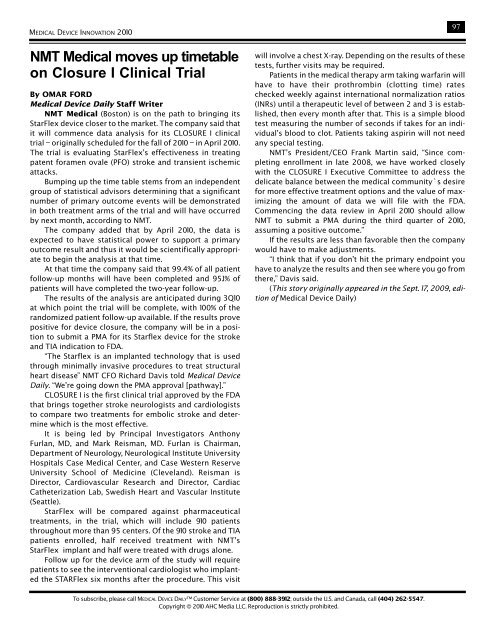MEDICAL DEVICE INNOVATION - Medical Device Daily
MEDICAL DEVICE INNOVATION - Medical Device Daily
MEDICAL DEVICE INNOVATION - Medical Device Daily
You also want an ePaper? Increase the reach of your titles
YUMPU automatically turns print PDFs into web optimized ePapers that Google loves.
<strong>MEDICAL</strong> <strong>DEVICE</strong> <strong>INNOVATION</strong> 2010<br />
NMT <strong>Medical</strong> moves up timetable<br />
on Closure I Clinical Trial<br />
By OMAR FORD<br />
<strong>Medical</strong> <strong>Device</strong> <strong>Daily</strong> Staff Writer<br />
NMT <strong>Medical</strong> (Boston) is on the path to bringing its<br />
StarFlex device closer to the market. The company said that<br />
it will commence data analysis for its CLOSURE I clinical<br />
trial – originally scheduled for the fall of 2010 – in April 2010.<br />
The trial is evaluating StarFlex’s effectiveness in treating<br />
patent foramen ovale (PFO) stroke and transient ischemic<br />
attacks.<br />
Bumping up the time table stems from an independent<br />
group of statistical advisors determining that a significant<br />
number of primary outcome events will be demonstrated<br />
in both treatment arms of the trial and will have occurred<br />
by next month, according to NMT.<br />
The company added that by April 2010, the data is<br />
expected to have statistical power to support a primary<br />
outcome result and thus it would be scientifically appropriate<br />
to begin the analysis at that time.<br />
At that time the company said that 99.4% of all patient<br />
follow-up months will have been completed and 95.1% of<br />
patients will have completed the two-year follow-up.<br />
The results of the analysis are anticipated during 3Q10<br />
at which point the trial will be complete, with 100% of the<br />
randomized patient follow-up available. If the results prove<br />
positive for device closure, the company will be in a position<br />
to submit a PMA for its Starflex device for the stroke<br />
and TIA indication to FDA.<br />
“The Starflex is an implanted technology that is used<br />
through minimally invasive procedures to treat structural<br />
heart disease” NMT CFO Richard Davis told <strong>Medical</strong> <strong>Device</strong><br />
<strong>Daily</strong>. “We’re going down the PMA approval [pathway].”<br />
CLOSURE I is the first clinical trial approved by the FDA<br />
that brings together stroke neurologists and cardiologists<br />
to compare two treatments for embolic stroke and determine<br />
which is the most effective.<br />
It is being led by Principal Investigators Anthony<br />
Furlan, MD, and Mark Reisman, MD. Furlan is Chairman,<br />
Department of Neurology, Neurological Institute University<br />
Hospitals Case <strong>Medical</strong> Center, and Case Western Reserve<br />
University School of Medicine (Cleveland). Reisman is<br />
Director, Cardiovascular Research and Director, Cardiac<br />
Catheterization Lab, Swedish Heart and Vascular Institute<br />
(Seattle).<br />
StarFlex will be compared against pharmaceutical<br />
treatments, in the trial, which will include 910 patients<br />
throughout more than 95 centers. Of the 910 stroke and TIA<br />
patients enrolled, half received treatment with NMT’s<br />
StarFlex implant and half were treated with drugs alone.<br />
Follow up for the device arm of the study will require<br />
patients to see the interventional cardiologist who implanted<br />
the STARFlex six months after the procedure. This visit<br />
97<br />
will involve a chest X-ray. Depending on the results of these<br />
tests, further visits may be required.<br />
Patients in the medical therapy arm taking warfarin will<br />
have to have their prothrombin (clotting time) rates<br />
checked weekly against international normalization ratios<br />
(INRs) until a therapeutic level of between 2 and 3 is established,<br />
then every month after that. This is a simple blood<br />
test measuring the number of seconds if takes for an individual’s<br />
blood to clot. Patients taking aspirin will not need<br />
any special testing.<br />
NMT’s President/CEO Frank Martin said, “Since completing<br />
enrollment in late 2008, we have worked closely<br />
with the CLOSURE I Executive Committee to address the<br />
delicate balance between the medical community`s desire<br />
for more effective treatment options and the value of maximizing<br />
the amount of data we will file with the FDA.<br />
Commencing the data review in April 2010 should allow<br />
NMT to submit a PMA during the third quarter of 2010,<br />
assuming a positive outcome.”<br />
If the results are less than favorable then the company<br />
would have to make adjustments.<br />
“I think that if you don’t hit the primary endpoint you<br />
have to analyze the results and then see where you go from<br />
there,” Davis said.<br />
(This story originally appeared in the Sept. 17, 2009, edition<br />
of <strong>Medical</strong> <strong>Device</strong> <strong>Daily</strong>)<br />
To subscribe, please call <strong>MEDICAL</strong> <strong>DEVICE</strong> DAILY Customer Service at (800) 888-3912; outside the U.S. and Canada, call (404) 262-5547.<br />
Copyright © 2010 AHC Media LLC. Reproduction is strictly prohibited.
















